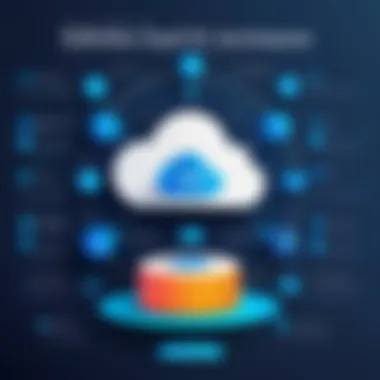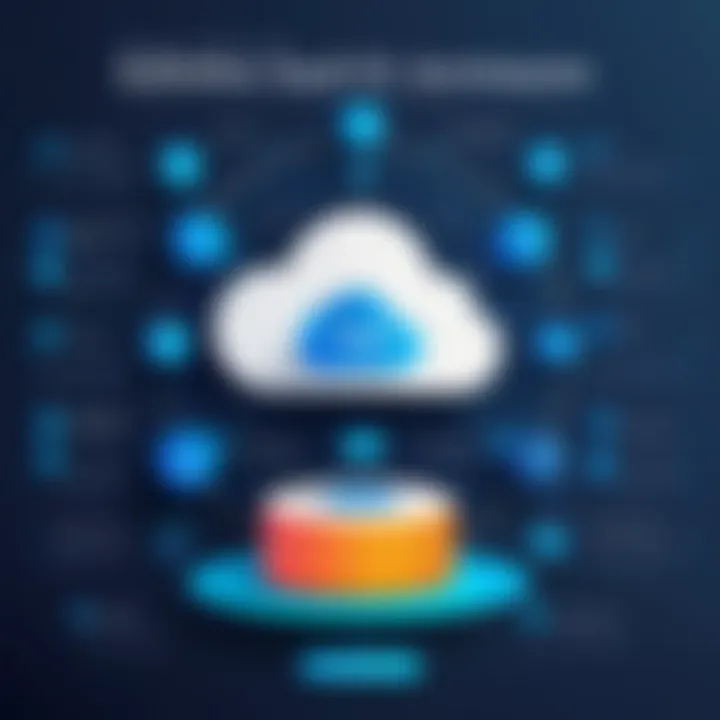Understanding the SaaS Subscription Database Model


Intro
The shift towards Software as a Service (SaaS) solutions has been rapid and transformative. The SaaS subscription database model stands at the forefront of this evolution. Organizations, whether small enterprises or large corporations, increasingly rely on these models to streamline operations and reduce costs. Understanding this framework is critical, especially for decision-makers and IT professionals who shape the technological landscape of their organizations.
This article unfolds the various aspects of the SaaS subscription database model, focusing on its architecture, benefits, challenges, and implementation strategies. By dissecting the components of this model, readers gain insights that enhance their capacity to make informed decisions tailored to their unique industry environments.
Software Overview
Brief Description of Software
The SaaS subscription database model provides a way for businesses to access software applications over the internet. Rather than hosting the application in-house, companies subscribe to the software, which is managed by a third party. This model typically involves a monthly or annual fee, allowing organizations to utilize software without the burden of installation, maintenance, and updates.
Key Features and Functionalities
- Accessibility: Users can access applications from any location with internet connectivity.
- Scalability: Companies can easily adjust their subscription levels based on changing needs.
- Automatic Updates: Software updates occur regularly without user intervention.
- Cost-Effective: Reduces the initial capital expenditure of purchasing software licenses and server infrastructure.
- Collaboration: Allows multiple users to collaborate on tasks, improving workflow efficiencies.
"SaaS models not only offer flexibility but also reduce the toll of ongoing IT management."
Detailed Comparison
Comparison with Competitors
The SaaS subscription database model is often compared to traditional software licensing and other software delivery models. Key differences include:
- Deployment: SaaS is cloud-based, while traditional software is installed locally.
- Cost Structure: SaaS typically employs a subscription pricing model versus a one-time purchase cost.
- Maintenance: SaaS providers handle upgrades, while traditional models require in-house IT support.
Pricing Structure
Pricing varies between SaaS solutions, but common structures include:
- Freemium: Basic features at no cost, with charges for premium functions.
- Tiered Pricing: Different levels of service and support at varying costs.
- Per-User Pricing: Charges based on the number of users accessing the service.
This understanding of pricing structures helps organizations assess the financial implications of adopting a SaaS model.
Ending
As businesses gravitate towards SaaS solutions, a thorough grasp of the subscription database model is imperative for effective decision-making. Recognizing the various elements and unique advantages of this approach empowers enterprises to leverage technology strategically in their operations.
Prelims to SaaS Subscription Database Model
The SaaS subscription database model represents a significant evolution in software delivery and database management. This model emphasizes not only the software's functionality but also the underlying data management systems that support it. Understanding this model is crucial for decision-makers and IT professionals seeking to leverage SaaS solutions effectively. In an era where businesses are increasingly dependent on cloud-based applications, the structure and performance of these systems are paramount.
Defining SaaS
Software as a Service (SaaS) is a software distribution model in which applications are hosted in the cloud and accessed via the internet. Users typically subscribe to the service rather than purchasing it outright. This model allows for automatic updates and patches, reducing the need for manual maintenance on the user's part. The delivery of software through a subscription model has transformed how organizations implement technology, making it more adaptable and up-to-date.
Overview of Subscription Database Models
The subscription database model under SaaS is characterized by its multi-tenant architecture. In such a system, multiple users share the same database and application instance while keeping their data isolated. This contrasts with traditional on-premises databases, where each client often has a separate installation. Subscription models often utilize a relational database like PostgreSQL or a NoSQL solution depending on their specific use case. Data is organized and stored in a way that optimizes accessibility and performance across all tenants.
Importance in Modern Software Development
Key Components of SaaS Subscription Database Model
The SaaS Subscription Database Model is structured around several core components, each of which plays a critical role in the overall effectiveness of the system. Understanding these components is essential for organizations that wish to leverage SaaS solutions to optimize their operations. Key components include the architecture, data storage mechanisms, and user access and authentication systems. Each element contributes to the security, scalability, and usability of the application, which directly impacts user experience and business outcomes.
Architecture Overview
The architecture of a SaaS subscription model primarily revolves around a multi-tenant framework. This means that a single instance of the software runs on a server, serving multiple clients. Each client's data is isolated within the database, ensuring security while optimizing resource utilization. An important aspect of this architecture is the use of microservices. Microservices allow developers to deploy and manage various functionalities independently, enhancing flexibility and reducing the implications of failure.
Moreover, utilizing cloud infrastructure, such as Amazon Web Services or Microsoft Azure, provides the scalability needed to handle variable workloads. The capacity to swiftly deploy services not only saves time but also reduces costs associated with infrastructure management. This architectural approach enables organizations to remain agile in a fast-evolving market.


Data Storage Mechanisms
Data storage in SaaS models is critical to the performance and reliability of the software. Typically, two primary mechanisms are employed: relational databases and NoSQL databases. Relational databases, like MySQL or PostgreSQL, offer structured data storage, which is vital for applications with complex transactions and relationships. In contrast, NoSQL databases like MongoDB provide flexibility to handle unstructured data, making them ideal for applications requiring quick iterations and scalability.
Key considerations for data storage include:
- Data integrity: Mechanisms must be in place to ensure that data remains consistent and accurate across various transactions.
- Scalability: The chosen storage solution should effortlessly expand to accommodate increasing volumes of data.
- Accessibility: Storing data in a way that makes it accessible for real-time analysis is crucial for businesses focusing on data-driven decisions.
User Access and Authentication
User access and authentication are paramount in a SaaS environment. As multiple users access the system, ensuring secure and efficient authentication processes is fundamental. Typically, this includes techniques like Single Sign-On (SSO) and Multi-Factor Authentication (MFA). SSO allows users to access various services using one set of login credentials, enhancing usability. On the other hand, MFA adds layers of security by requiring additional verification methods beyond just a password.
It's also essential to implement role-based access control (RBAC), which defines permissions according to user roles. This ensures that sensitive data remains secure while allowing users to perform their necessary functions without unnecessary hindrances.
"Establishing a comprehensive user access and authentication strategy minimizes security risks while improving user experience".
Benefits of the SaaS Subscription Database Model
The SaaS subscription database model presents numerous advantages that are pivotal for modern businesses. As organizations adopt this model, understanding these benefits becomes increasingly important. Companies must consider factors like cost, flexibility, and collaboration opportunities.
Cost-Effectiveness
One of the primary advantages of the SaaS subscription model is cost-effectiveness. Companies often face substantial upfront expenses when adopting traditional software solutions. In contrast, SaaS typically employs a subscription-based pricing structure. This model allows businesses to avoid significant capital expenditures, as they pay only for what they need on a monthly or annual basis.
Additionally, many SaaS providers offer tiered pricing plans, enabling organizations to select options that fit their budget and requirements. This pricing structure can lead to significant savings over time.
- Lower Initial Costs: Businesses save on hardware and installation costs.
- Predictable Expenses: Regular subscription fees provide a clear financial roadmap.
- Reduction in IT Overhead: Maintenance and updates are managed by the provider, minimizing the need for extensive internal IT resources.
"Choosing a SaaS solution can reduce overall operational costs and streamline budget management."
Scalability and Flexibility
Scalability is another critical benefit of SaaS subscription models. Organizations can adjust their subscriptions according to their current needs. This means that if a business expands, it can easily add more users, increase storage, or access additional features without the challenges associated with traditional software solutions.
The flexibility inherent in this model also means that companies can choose services that align closely with their evolving requirements. Businesses in dynamic industries can adapt swiftly, ensuring they remain competitive. This model provides a flexible environment to support fast-paced changes in technology and user demands.
- Easy User Additions: Organizations can expand usage quickly.
- Feature Upgrades: Businesses can adapt to new functionalities as they become available.
- Global Availability: Most SaaS offerings are accessible from various locations, promoting remote work.
Accessibility and Collaboration
Accessibility is paramount in today’s work environment. SaaS subscription models offer users the ability to access applications from virtually anywhere with an internet connection. This is particularly advantageous as remote work becomes more prevalent. Employees can collaborate seamlessly regardless of their location, enhancing productivity.
Furthermore, these models often support collaboration tools that integrate directly with SaaS applications. Features such as real-time data sharing and communication enhance team synergy.
- Anytime Access: Users can manage tasks on-the-go.
- Collaborative Tools: Shared documents and workspaces boost teamwork.
- Cross-Platform Compatibility: SaaS applications often function well on various devices, simplifying usage for all employees.
In summary, the SaaS subscription database model offers a range of benefits including cost-effectiveness, scalability, and enhanced accessibility, providing organizations with significant operational advantages.
Challenges and Limitations of the SaaS Model
Understanding the challenges and limitations of the SaaS model is crucial for any organization considering this approach to software deployment. While SaaS presents numerous advantages, it is not without its drawbacks. Decision-makers and IT professionals must be aware of these issues to make informed decisions that support their business objectives. From data security concerns to vendor lock-in, recognizing these challenges enables companies to strategize effectively and mitigate risks associated with SaaS solutions.
Data Security Concerns
Data security is often cited as one of the most significant challenges in the SaaS model. Organizations leverage SaaS solutions to store sensitive information, making security a paramount concern. Providers typically implement various security measures, including data encryption, multi-factor authentication, and regular security audits. However, the degree of security can vary widely between vendors. Organizations must conduct thorough due diligence when selecting a SaaS provider.
Considerations may include evaluating the provider's compliance with industry-specific regulations such as GDPR, HIPAA, or PCI-DSS. Additionally, companies should assess the provider's incident response policies. A clear understanding of how the vendor handles breaches can significantly impact risk management strategies.
"Data protection frameworks play a vital role in how organizations assess SaaS providers."
Given the interconnected nature of SaaS applications, vulnerabilities can arise from third-party integrations and APIs. A breach in one application may potentially expose others. As such, maintaining strong governance and oversight is essential. Organizations should implement stringent access controls to ensure that only authorized personnel have access to sensitive data.
Dependence on Internet Connectivity


SaaS applications operate on the assumption of consistent internet connectivity. This requirement can pose significant limitations for organizations operating in areas with unreliable internet service. Outages or slow connections can severely impact productivity.
It becomes crucial for decision-makers to understand their internet infrastructure before fully committing to a SaaS solution. Many SaaS providers offer performance guarantees based on uptime, but these guarantees may not account for local connectivity issues.
Organizations should consider establishing backup connectivity options for critical applications to mitigate risks associated with internet outages. Furthermore, evaluating the extent to which a SaaS application can function offline can help in assessing potential impact during connectivity interruptions.
Vendor Lock-In Issues
Vendor lock-in is another notable challenge inherent to the SaaS model. As organizations invest in specific SaaS solutions, they often become reliant on a single vendor for their software needs. This can create difficulties should the need arise to switch vendors or migrate to an in-house solution.
The proprietary nature of many SaaS applications can complicate data migration processes. Organizations must carefully review the terms of service and data portability options before engaging with a provider. Understanding how easily data can be exported and whether the vendor supports industry-standard data formats is essential.
Addressing vendor lock-in concerns requires proactive measures. Here are some strategies organizations can utilize:
- Discuss contract lengths and exit strategies during negotiation.
- Assess compatibility with alternative solutions to facilitate migration if needed.
- Maintain detailed documentation of data structures to ease migration processes.
Understanding these challenges and limitations allows organizations to approach SaaS implementations with a well-rounded perspective. This, in turn, fosters better planning and risk management, ultimately leading to a more fruitful experience with SaaS technologies.
Implementing the SaaS Subscription Database Model
Implementing the SaaS subscription database model is a critical step for organizations looking to modernize their software solutions. This transition represents more than just technical adjustments; it requires strategic foresight and careful planning. The implementation process can greatly influence the overall effectiveness of the SaaS platform, impacting user experience and return on investment. Organizations must pay attention to several key elements to successfully navigate this landscape.
The right implementation approach can enhance business agility and operational efficiency. Also, it allows businesses to leverage cloud capabilities, managing resources in a more streamlined manner. Following a structured implementation plan paves the way for seamless integration with existing systems and ensures data integrity throughout the transition.
Key Considerations for Implementation
When implementing the SaaS subscription database model, organizations should carefully consider the following:
- Assessment of Needs: Understanding specific business requirements is crucial. This involves identifying which processes will benefit most from SaaS adoption.
- Infrastructure Readiness: Check if the current infrastructure supports SaaS solutions. Connectivity and system compatibility are key.
- Budget Constraints: Evaluate the financial aspects of implementing a new solution. Include potential subscription costs and hidden expenses.
- User Training: Prepare teams for the change by facilitating thorough training sessions. This ensures all users are competent and comfortable with the new system.
Choosing the Right Vendor
Selecting the right vendor is one of the most significant parts of implementing the SaaS subscription model. The vendor must align with the organization’s goals and specific needs. Here are factors to consider:
- Reputation and Reliability: Research the vendor’s track record in the industry. Look for case studies or reviews that highlight their commitments to customer support and service reliability.
- Compliance and Security Standards: Ensure that the vendor adheres to relevant compliance frameworks, such as GDPR or HIPAA, depending on the industry.
- Integration Capabilities: Determine how well the vendor's solution can integrate with existing applications and systems. This affects the ease of implementation and future adaptability.
Customization and Configuration Needs
Customization is another important aspect of implementing the SaaS subscription database model. Organizations often have unique requirements that may necessitate specific configurations to maximize the effectiveness of the software. Here are some points to consider:
- Tailoring Features: Depending on the organization's needs, it might be necessary to adjust features and functionalities of the SaaS application. This can help meet specific operational requirements.
- User Interface Configuration: The user interface should be configured for ease of use, making it intuitive for all users. A well-designed UI can enhance productivity and user satisfaction.
- Ongoing Support for Changes: As business needs evolve, so should the SaaS application. Ensure the vendor offers ongoing support for future modifications and configurations. This adaptability can be pivotal for long-term success.
"Successful implementation is not just about installing software; it’s about integrating technology into the very fabric of the organization’s operations."
In summary, implementing the SaaS subscription database model involves several key steps and considerations. Proper planning and a focus on the right vendor, user training, and customization can lead to a significant improvement in how organizations manage their software resources. It’s essential to approach this journey with diligence to fully realize the potential benefits that SaaS technologies can offer.
Data Management in SaaS Subscriptions
In the context of SaaS subscriptions, effective data management is crucial for ensuring system reliability, user satisfaction, and regulatory compliance. As businesses increasingly rely on cloud-based solutions, the way data is handled can significantly impact an organization's overall performance. Key components of data management in this model involve data backup, recovery strategies, and addressing the challenges of data migration. Each of these elements plays a vital role in maintaining continuity and integrity of service.
Data Backup and Recovery Strategies
A robust data backup and recovery strategy is essential for any SaaS application. This strategy protects against data loss due to various reasons, including accidental deletion, system failures, or security breaches. Effective backup solutions can provide peace of mind for organizations, knowing their data is secure and can be restored quickly if necessary.
Consider the following strategies when developing a data backup plan:
- Frequency of Backups: Determine how often the data should be backed up. This could be daily, weekly, or even in real-time, depending on the critical nature of the data.
- Backup Locations: Utilize multiple backup locations, combining on-premises storage and cloud-based solutions. This ensures that data remains accessible even in the event of a site failure.
- Testing Recovery Processes: Regularly test the recovery process to ensure that backups can be restored swiftly and accurately. This testing identifies potential issues in advance.
Backup solutions vary from simple file storage to more sophisticated database backup techniques. Employing established tools like Amazon S3 or Google Cloud Storage can help streamline the backup process and provide reliable recovery options.
Data Migration Challenges


Data migration is a common aspect when transitioning to a SaaS subscription model. Whether moving data from legacy systems or consolidating various databases, organizations often face a slew of challenges. These challenges must be addressed for a smooth transition to a SaaS environment.
Some of the main challenges include:
- Data Compatibility: Aligning the structure of data from different sources can be complex. There may be discrepancies in formats, types, or hierarchical structures that need to be standardized.
- Data Integrity: Ensuring data integrity throughout the migration process is paramount. Any loss or corruption can lead to significant operational issues.
- Time Constraints: Data migrations can be time-consuming. Planning for enough time to execute the migration properly, while avoiding disruption to business operations, is critical.
Furthermore, organizations should provide training for staff involved in the migration process. Understanding the tools for migration and the new system will ease the transition and minimize errors.
"Inadequate data management can lead to disastrous consequences, making a solid strategy imperative for success."
Hence, adequately addressing data management matters in SaaS subscriptions enhances reliability, fosters trust with customers, and supports business growth. The ability to ensure effective backups and manage migration challenges lays the groundwork for a successful implementation of SaaS solutions.
Future Trends in SaaS Subscription Database Models
The landscape of SaaS subscription models is continually evolving, influenced by technological advances and shifting user preferences. Understanding future trends enables businesses to adapt, innovate, and maintain competitive advantages. In this section, we will explore significant trends that are shaping the future of SaaS subscription database models.
Emergence of New Technologies
New technologies are emerging rapidly, impacting SaaS database models significantly. Advances in artificial intelligence, machine learning, and cloud computing are at the forefront of this transformation. These technologies enhance automation, improve data management, and streamline operations.
- Artificial Intelligence (AI): AI enables better data analysis capabilities, offering insights that were previously unattainable. Organizations can now leverage AI to predict user needs, optimize services, and personalize experiences.
- Machine Learning (ML): Integrating ML into SaaS applications allows for continuous improvement based on user interactions. This enhances the efficacy of applications by learning from user behavior and optimizing workflows accordingly.
- Serverless Computing: This trend minimizes infrastructure management, allowing developers to focus on code and functionality. By leveraging serverless architectures, businesses can reduce costs and improve scalability, adapting resources dynamically based on demand.
These technologies not only improve operational efficiencies but also enhance user experiences. Thus, companies need to stay informed about emerging tech to capitalize on these trends.
Changing User Expectations
As the SaaS market expands, user expectations are also evolving. Today’s customers demand more than basic functionalities; they seek personalized, efficient, and accessible services. This shift is a crucial consideration for SaaS providers aiming to sustain user satisfaction and retention.
- User-Centric Designs: Modern users expect intuitive interfaces that simplify their tasks. This demands that SaaS applications prioritize user experience through thoughtful design and easy navigation.
- Integration Capabilities: Users now seek seamless interoperability between different software solutions. SaaS providers must ensure that their platforms can easily integrate with other applications to enhance usability and minimize disruptions.
- Feedback Loops: Continuous feedback collection is essential. Users expect their concerns and suggestions to be taken seriously. Organizations that actively seek and incorporate feedback build stronger relationships with their customers.
In summary, adapting to changing user expectations is not optional; it is vital for success. Companies should be proactive in identifying and responding to these expectations to foster loyalty and drive growth.
The future of SaaS is defined by innovation and responsiveness, where companies that actively embrace new technologies and user feedback are likely to thrive.
Case Studies of Successful Implementations
The examination of case studies brings invaluable insights into the practical application of the SaaS subscription database model. By analyzing specific implementations, organizations can better understand how different features and components can meet diverse business needs. The reactions of early users provide perspectives about the advantages and shortfalls of the model, assisting decision-makers in navigating their own SaaS journey. These insights highlight the effectiveness of the model and the real-world implications of choosing certain practices over others.
Industry-Specific Examples
Industry-specific examples effectively showcase the versatility of the SaaS subscription database model across various sectors. Each industry varies in needs and objectives, illustrating how tailored approaches in SaaS can deliver effective solutions.
- Healthcare Sector: Healthcare organizations increasingly adopt SaaS platforms for enhanced patient management. A platform like Kareo offers tools that enable practitioners to manage patient records and billing seamlessly. These capabilities enhance operational efficiency and improve patient care outcomes.
- E-Commerce: In the retail field, platforms such as Shopify illustrate how SaaS models facilitate online sales. Shopify provides merchants with the ability to host their stores, manage inventory, and analyze consumer behavior, essential for competing in a digital marketplace.
- Education: Institutions like Quizlet leverage SaaS to deliver educational resources. It provides tools for collaborative learning and assessment, enabling students and educators to engage efficiently in diverse learning environments.
- Finance: Companies like Intuit QuickBooks have developed a SaaS product aimed at financial management. This application allows small businesses to handle accounting, payroll, and tax preparation all in one interface.
These examples shine a light on the adaptability and effectiveness of SaaS in addressing specific industry challenges.
Lessons Learned from Early Adopters
The experiences of early adopters serve as a valuable compass for organizations that are considering implementing a SaaS subscription database model. By observing the initial challenges and triumphs, businesses can refine their own strategies to maximize benefits.
- Flexibility Matters: Many early users have emphasized the need for flexibility in customization to adapt to specific workflows. Organizations should prioritize vendors that allow for easy integration with existing systems.
- Data Security Protocols: Security was a prime concern for early adopters. Organizations reported better outcomes when they established clear data governance policies before engaging with a SaaS vendor. This underscores the importance of understanding security features provided by the platform.
- Change Management Strategies: Resistance to change was common. The most successful implementations resulted from thorough change management practices, including comprehensive staff training and communication about expected outcomes.
- Continuous Feedback Loop: Establishing mechanisms for ongoing user feedback can drive iterative improvements in the system. Early adopters that utilized customer input effectively enhanced their user experience over time.
The journey of these early adopters serves as a guide and highlights that thorough comprehension of the SaaS model's aspects, supported by case studies, can lead to more successful implementation outcomes.
End
Recap of Key Points
In reviewing the key facets discussed, we can highlight several critical elements:
- Definition and Importance of SaaS: SaaS has reshaped how software is delivered and consumed by providing scalable and flexible solutions.
- Key Components: The essential components include the architecture, data storage mechanisms, and user access protocols, all of which contribute to the functionality of the SaaS model.
- Benefits: Cost-effectiveness, scalability, and enhanced collaboration are some of the primary benefits.
- Challenges: Security concerns, dependence on internet connectivity, and vendor lock-in present challenges that organizations must navigate.
- Data Management: Effective strategies for data backup, recovery, and migration are crucial for successful SaaS implementation.
- Future Trends: Emerging technologies and shifting user expectations continue to influence the evolution of the SaaS subscription model.
Final Thoughts on SaaS Subscription Models
The ongoing advancement in technologies and evolving user demands signal that the SaaS subscription model will continue to change. Understanding the underlying principles will equip businesses to adapt accordingly, ensuring they maximize the benefits while mitigating any inherent risks.
"A well-informed decision in SaaS selection can unlock significant value through enhanced efficiency and productivity."
By embracing the knowledge from this article, professionals can effectively navigate the complexities of SaaS subscription models, contributing to their organization’s success in an increasingly digital world.







